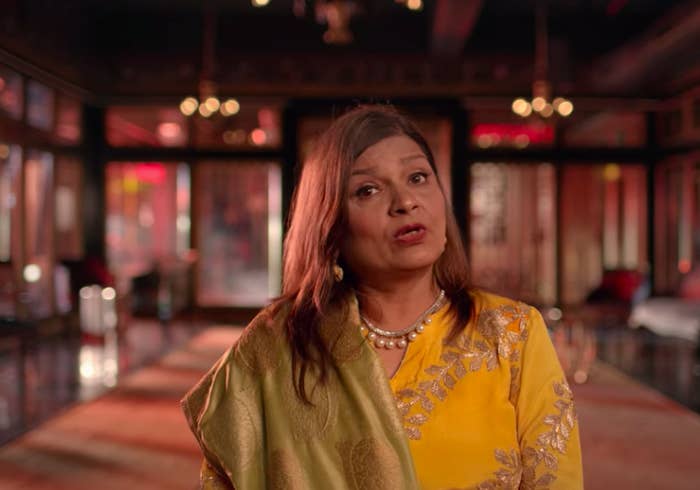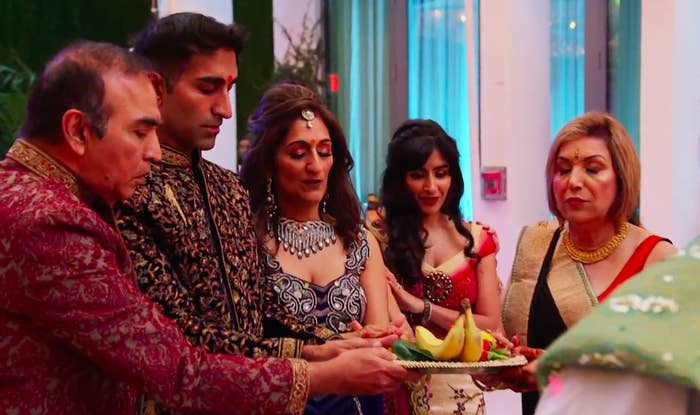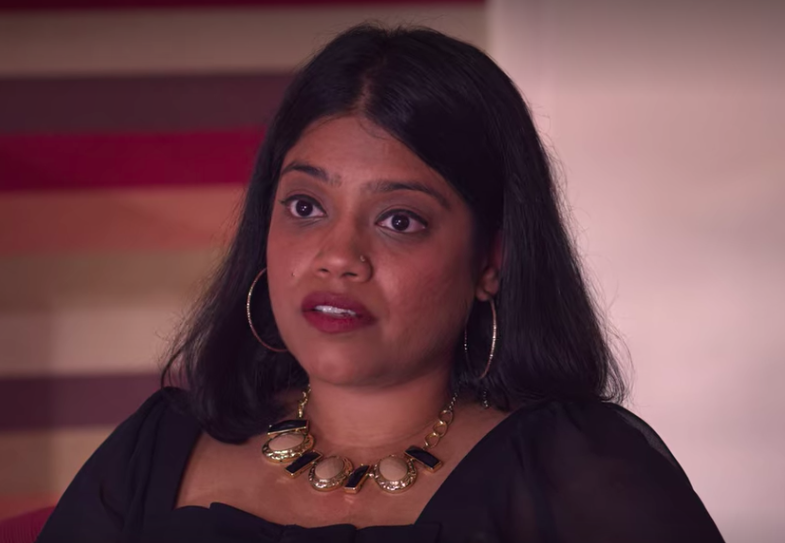
Not a single person has talked to me in the last two weeks without our conversation veering into the same territory: “Hey, have you seen Indian Matchmaking?”
And of course I have. As an Indian person, it’s practically my duty (and also my joy) to consume any and all content about brown people, especially when it’s made by and for Americans. The same was true for Family Karma, the Bravo reality show that recently wrapped its first season, and for the Aladdin remake, which was not only terrible but isn’t even about Indian people. (I really cannot stress this enough: Agrabah is not a real place!)
It’s always exciting when a show is made for and by us, a rarity especially in reality television. The genre, after all, encapsulates so much of the human condition, from its elegant docuseries to the shows where women throw wine at each other while their husbands mutter anti-gay slurs in the background. (Art! High art!)
Netflix’s Indian Matchmaking and Bravo’s Family Karma are very different products targeting the same community. Indian Matchmaking is another notch in Netflix’s reality-dating-show belt. A well-lit, well-produced, empathetic docuseries, it follows matchmaker Sima Taparia as she tries to set up Indians both in India and the US for arranged marriages. It’s a show clearly intended to be respectable and nuanced about the marriage industrial complex, but it often fails, letting the cast’s sexism, shadism, and casteism go unchecked. Then there’s Family Karma, which is standard Bravo fare, following a few Indian American families based out of Miami. The fights are lukewarm compared to anything else on that network, but I suppose it’s nice enough to see some aunties get into scraps on national television.
But both series have felt unsatisfying to me. It’s not necessarily because they’re unenjoyable or because they’re wholly inaccurate representations of Indian life in America. Rather, I think I’m just tired of reality television shows about South Asian people rooted entirely in how their culture makes their lives infinitely harder.
There just isn’t a lot of content made about brown people living in predominantly white countries. Mindy Kaling comes out with something new every few years, which many Indian Americans find exciting, and the work of brown women is sorely needed in a white media landscape. A lot of us are very proud of Lilly Singh getting on late-night television — though I could really, really do without her mimicking patois, something she has done more times than I can count, I don’t care where she grew up — but otherwise, it’s comparatively slim pickings.

South Asian people living in America occupy a strange cultural space; music, movies, and television aren’t really made for us, nor are they made by us, nor do they really consider us all that frequently. We also don’t influence culture the way Black musicians, actors, and artists deservedly do (though, often without sufficient credit, and often with the result of being appropriated and then ignored). Some Indian people (like myself) benefit from being Brahmin Hindus with fair skin and straight hair and last names that tell you exactly what caste we were born into. We become a wedge minority. Even though nothing is really for us, we get some of it anyway. Our proximity to whiteness, especially in contrast to Black and darker-skinned brown people, means that television shows made for and by white people can sometimes inadvertently speak to us. It’s not enough, but it’s a sliver of the pie. I suppose I should be grateful?
So what would an audience — namely a predominantly white audience — take away from shows like Family Karma and, more urgently, Indian Matchmaking? That being Indian is a nuisance? That your family is constantly on your ass? That there’s no respite from the crushing, constant requirements set for you from birth? That our own inherent racism, classism, and sexism is a scourge that no one is even attempting to fight against?
I’m guilty of this myself; I effectively wrote an entire book a few years ago about how my ethnicity made my life tougher in white spaces. I’m not interested in erasing the hardships experienced by South Asians, but rather contextualizing it next to joy, fun, and delight. Desi culture is presented as a weight that every Indian has to lug through their life until they either get married, or their parents die, or both. You’re either a traditionalist — and thus, boring — or you’re a modernist, which means your life is destined to be filled with strife, forever bucking against your family and your culture. There are so few depictions of anything in between.
I’m not interested in erasing the hardships experienced by South Asians, but rather contextualizing it next to joy, fun, and delight.
Indian Matchmaking is an inherently flawed show, but as Mallika Rao pointed out in Vulture, that’s kind of the point. “On The Bachelor, where judgments based on skin color happen as a rule, a euphemism — that someone is not a ‘good fit’ — veils the truth,” Rao writes. “At least on this show, people state things in reflection of the warts-and-all truth … Marriage is a business and a game, whether in India or America, and grotesque from many angles.” It’s true that the show reveals a pretty honest, if ugly, interpretation of what the marriage industry looks like for Indians, but if we only get a few brief moments of representation every year, this isn’t really what I was hoping for.
If you watch Indian Matchmaking to get a sense of what it’s actually like to be Indian, you’re left with an upsetting — and hardly representative — picture. Aparna is morose and judgmental; Vyasar’s family history is complicated, which leads him to believe he’s wholly unlovable; Ankita is repeatedly told by her elders that she’s too old, too fat, too dark, and too ambitious to get married; Nadia claims she can’t find desi love because she’s Guyanese and mainland Indians question her South Asian bona fides; and Akshay is very clearly in love with his cousin while his mother has eight or nine heart attacks a day because her 25-year-old son still isn’t married.

These shows make South Asian identity seem uniquely fraught. On Indian Matchmaking, dating another Indian person seems like an impossible feat, or worse, it’s presented as a case of having to just settle for whoever will have you. The people featured — like Ankita — want a life partner, but one matchmaker tells her she has to be “flexible,” which just means she has to learn to let a man tell her what to do. Others, like Pradhyuman and Akshay, clearly just aren’t ready for marriage, and so we get another example of overbearing Indian parents forcing their child into a traditional marriage.
It’s striking only because there’s a dearth of American content about South Asian people, namely in the reality or docuseries space. We end up with an interpretation of Indian communities as miserable, one-note, and, above all, burdened. Being Indian ends up being synonymous with a hard, taxing life, one where you’re not only fighting your family, but fighting with your culture. On these shows, being Indian makes life more difficult. When do we get to have fun?
The representation we get from a show like Indian Matchmaking isn’t wrong, but it’s just one version of a story we’ve already heard: Indian moms are exhausting, marriage is mandatory, India is delayed in its progress as a culturally modern superpower. Fine, this is sometimes true, depending on where you go and who you talk to. But these stories are always about middle-class, or outright rich, people, Brahmin Hindus, and people who live in big cities like Mumbai and Delhi. They present being South Asian as such a drag.
And it’s not that being brown makes life harder. It’s the effects of colonialism and white supremacy that have stigmatized having darker skin; it’s sexism that perpetuates the idea that a woman can’t get married and have a career at the same time; classism is a huge influence too, but that’s not specific to brown communities either. My mother being a real dick about my childlessness isn’t inherently Indian, but were I on a reality show, I suspect it would somehow become an Indian issue first. Indians are far from the only community of people whose mothers are nightmares, but it often feels like such depictions are the representation we’re stuck with.
My mother being a real dick about my childlessness isn’t inherently Indian, but were I on a reality show, I suspect it would somehow become an Indian issue first.
Reality shows often show the hardships of their characters, in whatever form they come, but for Indian people on shows like Indian Matchmaking, it can sometimes feel as though these hardships are foremost rooted in our culture. I don’t feel burdened by my South Asian identity, by my family’s often archaic and frustrating rules, or by my big nose and consonant-heavy name. Rather, I feel burdened by the white supremacy that taught me not to go into the sun lest I get dark and by the sexism my father showed when he wanted me to get an arranged marriage.
Ridiculous though it may sound, I’d kill for a reality show featuring Indians where their lives don’t seem challenging, or inspirational (Jesus Christ), or where they aren’t maintaining the racist ideologies they’ve inherited from their parents. My kingdom for one, just one, South Asian character on a Real Housewives franchise. Jyoti can swing her hips around in a big yellow caftan on Sonja’s boat, a margarita goblet sloshing around in her hand. Or maybe Veerangana can pull Teresa’s hair in a fight about who has the smallest forehead. Am I really asking so much? Is it possible to be an Indian woman in the world and be a little more carefree? Is there a way to have our overbearing mothers, our fathers who want us to be doctors, our crushing Indian guilt, while also showing that brownness can be untroubled, easygoing, and — ultimately — fun?
A few weeks ago, I went on vacation to a quiet, secluded place. Every day was hotter than the day before. For maybe the first time in my life, I lay in the sun without layers of sunscreen, dutifully reapplied every hour. (I don’t necessarily recommend this, but I figure I can survive it just once.) I’m the darkest I’ve been in my life. My mother gasped when I sent her a photo of my legs, shiny and toasted, but there was no big fight about my coloring, no argument about what the aunties might think. My skin came with no burden; it came with no struggle; it came with no fight. It’s possible to live in this skin and still find joy. Doesn’t that sound nice? ●
